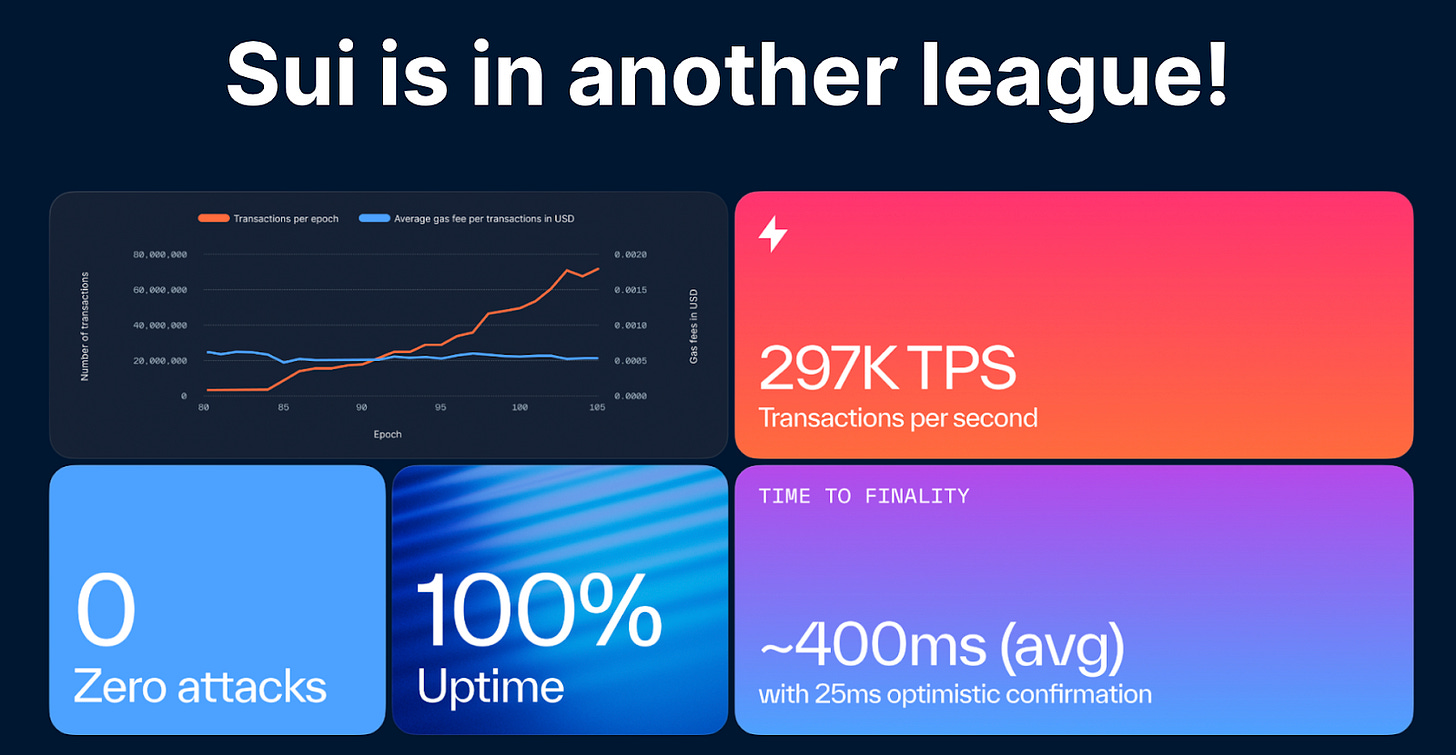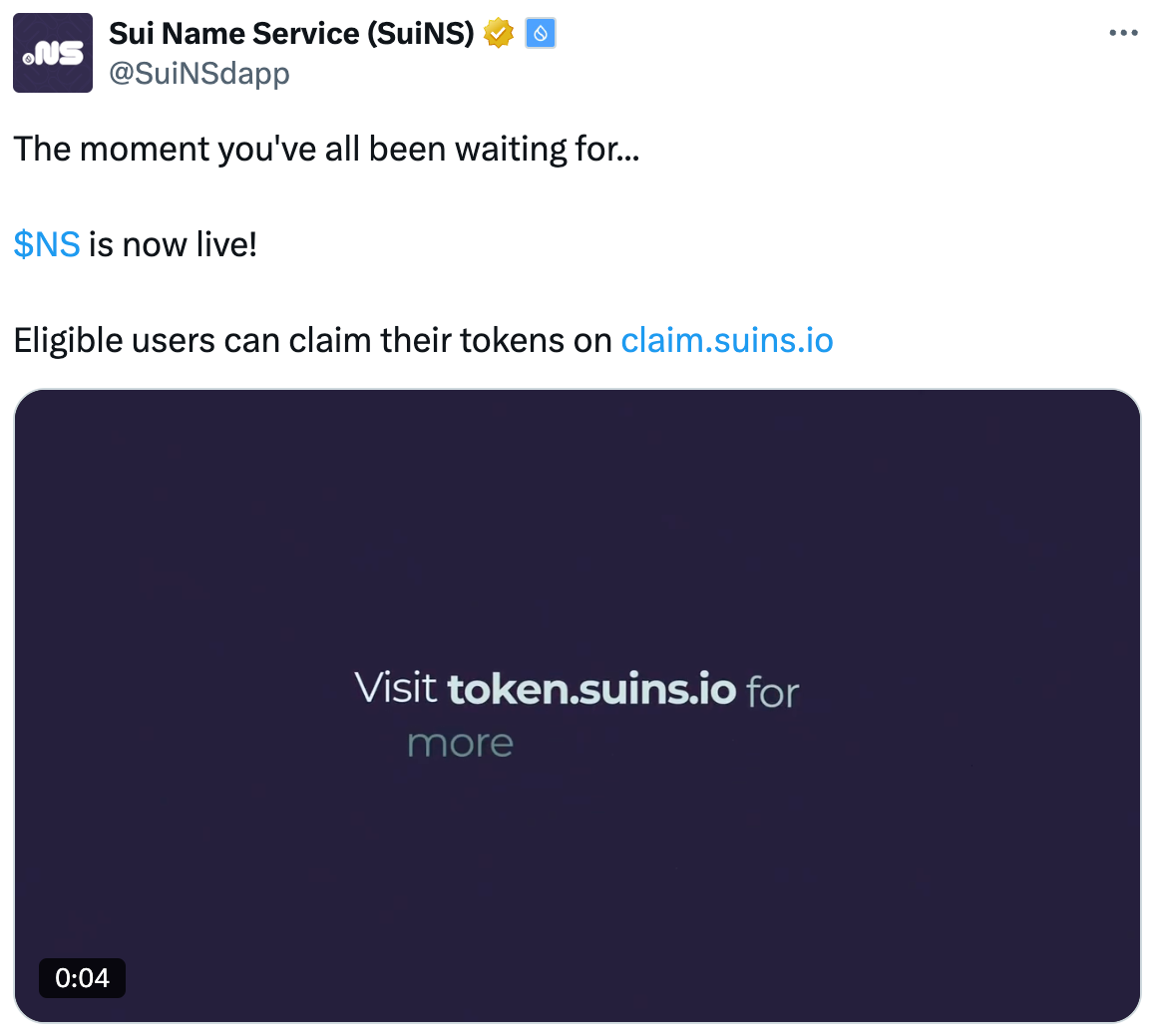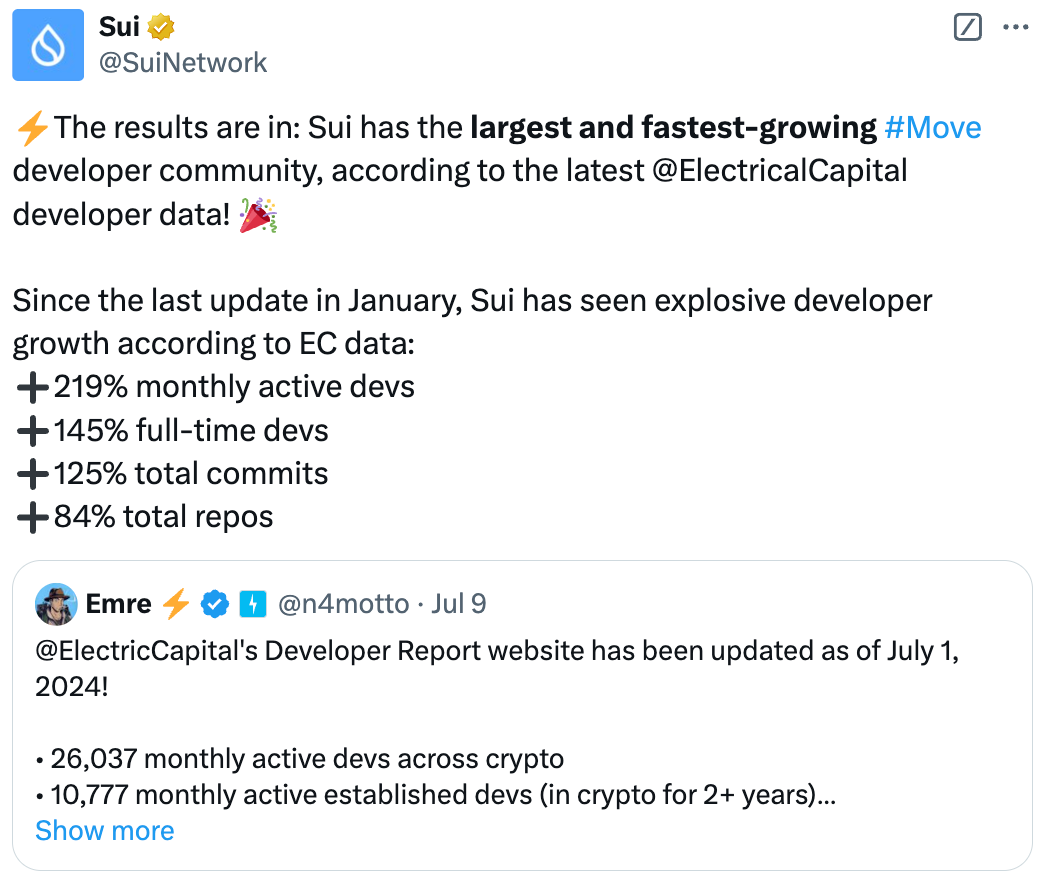2024 was the year we saw Sui truly come into its own as a smart contract platform.
Within just 18 months of mainnet, Sui grew from a complete newcomer to one of the most prominent ecosystems in the blockchain space.
This is the story of what Sui has achieved till date and how it lays the groundwork for what comes next.
BTW: Here’s the link to my Substack to stay posted:
In the span of eighteen months from the mainnet going live, we went from promising “sub-second finality and Web2-like UX” to actually delivering it, live, at scale, with real users and real money on the line.
And if you’re wondering how we did it so fast, well, that’s what happens when you take your time to build from the right foundation rather than rush to the market with half-baked solutions.
The last one and a half years were proof we’re on the right track, knocking down the “can’t be done” barriers one by one.
Starting With The Right Foundations
From day one, our mission has been crystal clear: lay down the bedrock for Sui to become THE GLOBAL COORDINATION LAYER FOR DIGITAL ASSETS.
A big part of that strategy is making sure developers can write code they trust and deploy it at scale.
In most chains, you are stuck with the account-based model, which was never designed for large-scale, asset-heavy applications.
You basically lump every user action into a single global space, and as soon as two transactions overlap, the system starts throttling.
Our first and foremost priority was to avoid this.
That is why we created the object-centric data model.
Sui treats tokens, NFTs, or any other assets as individual objects, each with its own ID and rules.
If you are building a game, you can represent characters, items, or levels as objects, each with clear ownership and logic.
If you are building a DeFi protocol, each pool or liquidity token can be its own object.
It is an approach that drastically reduces the friction in reasoning about what your code will do on-chain.
The big advantage is that the system knows exactly which parts of the state a transaction will touch before execution.
No guesswork, no universal locks on global state.
Want parallel execution? Done. Handling millions of user actions at the same time? You’ve got it.
Building on this object-centric architecture, we introduced Move as the smart contract programming language.
Built for Scale and Security From Day One
Sui’s object-centric data model and Move language form the bedrock of everything else we have built.
Because money is valuable, people believe it works. That trust is core to the mass adoption of financial applications.
If your base platform has weekly exploits or complicated concurrency issues, you lose that trust instantly.
If the developers trust they can write secure code at scale, and the users trust those apps to not self-destruct, you have a real shot at mainstream adoption.
The combination of an object-centric data model wrapped in the Move programming language is designed for Internet-scale, financial-grade applications.
In Move, you do not have to hack around outdated account models or live in fear of reentrancy every time you write a function.
Instead, you treat assets like real objects, each with its own structure, rules, and lifecycle.
By baking asset ownership directly into the language, Move frees developers from constantly reinventing the same security checks.
It ensures that the code you deploy does exactly what you intend, without the usual pitfalls that plague other ecosystems.
And the best part? Developers are telling us they can learn it in days, not months.
But here is the thing: developers do not code for coding’s sake; they create products that real people will depend on.
And the people (a.k.a. consumers) don’t want “better blockchain”; they want friction-free experiences they don’t even notice.
That's how you onboard the masses.
So our focus right from the beginning was on providing tools for developers to do exactly that.
We started with DeepBook
DeepBook is Sui’s native liquidity layer. It’s a fully on-chain, decentralized central limit order book (CLOB).
DeepBook bridges the gap between hardcore DeFi protocols and regular users who just want reliable, low-latency swaps without the usual blockchain pain points.
DeepBook lets projects like DEXs, wallets, and other apps tap into high-performance, on-chain order matching without spinning up their own infrastructure.
It’s a giant leap from the older, clunky approaches that either forced devs to reinvent the wheel or settle for half-baked liquidity solutions.
The latest version of DeepBook (V3) incorporates features like flash loans, governance modules, improved account abstraction, and a refined matching engine.
The Next Big Leap Was zkLogin
We knew our next big leap had to tackle an entirely different pain point: user onboarding.
Because let’s face it, if logging into your app feels like an advanced cryptography course, most folks will bail in a heartbeat.
That’s where zkLogin steps in.
IMO, zkLogin is by far one of the biggest innovations to happen in the blockchain space in the last half a decade or so.
With zkLogin, there’s no "wallet literacy test" to pass, just a session cookie and an off-chain identity they already trust.
For developers, that translates into a frictionless funnel: your prospective users can skip the usual hoops and dive straight into engaging with your app.
And the whole process is fully on-chain and fully decentralized.
IMO, zkLogin is by far one of the biggest innovations to happen in the blockchain space in the last half a decade or so.
And as of today, zkLogin stands as the most widely used application globally that leverages zero-knowledge proofs (ZKPs).
Then We Tackled The ‘Need for Speed’
It is one thing to nail user onboarding and dev experience, but none of that matters if your chain crawls when it is under real load.
That is why we built Mysticeti.
Mysticeti wasn’t just a “next step” for Sui; it was a leap in how we think about performance.
With Mysticeti we’re talking p95 latencies under a second, even at tens of thousands of transactions per second (tps).
This means actual sub-second finality, for the simplest transfer to the most complex DeFi swap.
Why does that matter?
Because every second (or fraction of a second) you shave off is another user who doesn’t bounce. It’s another dev who doesn’t have to build “Are we sure this is final?” logic.
It’s another instance of feeling Web2-level quickness but in a decentralized, trust-minimized context.
That’s a game-changer for high-volume DeFi (flash loans, complex swaps), gaming (real-time asset trades), or any use case where you need to confirm critical actions right now instead of “eventually.”
When your base layer can finalize transactions in the blink of an eye, you unlock real-world applications that go far beyond simple token swaps.
Developers can finally sleep easy knowing their dApps scale without having to MacGyver their own solutions for speed and reliability.
Then We Made Web3 Simple for Everyone
The next phase of Sui’s evolution was clear: making blockchain interactions as intuitive as possible.
That’s why we built tools like Sui NS and sponsored transactions.
Sui NS gives users the power to replace complex wallet addresses with simple, memorable names.
Instead of sending tokens to “0x1234,” you can send them to “alex@sui” or “developer@gamingguild.”
That shift from cryptic to human-readable is a big deal. It stops your average user from freezing the moment they see a scary hex address.
And more than that, it introduces brandability.
Now, your app or user handle can feel personal, not just a faceless string that looks like a glitch in the Matrix.
But Sui NS did not stop at just a friendlier UX. In 2024, the service took a major step forward by moving from a centrally controlled service to a fully community-run organization.
Sponsored transactions take things further by removing barriers like gas fees.
Developers can now cover costs, creating a frictionless onboarding process where users can focus on what matters: engaging with the application.
Together, these features bring usability to the forefront, showing how Web3 can be powerful without being complicated.
It's a leap toward making blockchain interactions feel as natural as everyday apps.
So, we removed the biggest user-facing friction points, and the next chapter tackled the big question:
How do we make the entire stack, from data storage to the networking layer, fully decentralized?
Decentralized Data Storage Was The Next Big Step
Let’s face it, if you’re still tied to a centralized platform for hosting NFT files, metadata, or Web3 app frontends, you’re just kicking the can down the road.
Without a storage layer that matches in scale, security, and programmability, you’re leaving gaps in the foundation.
You need a platform that can handle petabytes, exabytes in a decentralized manner, without turning into a slow, expensive headache.
So, for us, the obvious follow-up was solving data storage in a truly decentralized way.
That’s why we created Walrus.
Walrus is our vision of a distributed storage layer that runs with the same ethos as Sui itself: no single point of failure, massive scalability, and a built-in sustainable economic model.
Most blockchain storage systems stop at basic file saving or referencing.
Walrus goes further by letting developers build rules, compose with smart contracts, and unlock new use cases for data.
With Walrus, you can build truly end-to-end decentralized Apps.
You can store front-end files, user-generated content, or anything else you need. All of it is governed by the same trustless principles that Sui applies to the rest of the stack.
And it's already running on testnet.
Now, the final piece of the puzzle was the integration of a bulletproof networking layer.
Securing The Last Mile With SCION Integration
Sui can have the best consensus and dev tools, but if the network is stuck in 1990s routing land, it falls short of meeting its full potential.
It might sound like we are going overboard, but if Sui is going to be the global coordination layer for digital assets, Sui needs that extra resilience.
So, we started working on integrating SCION, a path-aware, DDoS-resistant networking layer.
Think of SCION as giving Sui a dedicated autobahn for node-to-node communication, free from the usual choke points and vulnerabilities you get in standard IP routing.
In practical terms, SCION means Sui validators remain connected, stable, and secure, even under adverse network conditions.
No single route hijack, no single ISP fiasco, or even severed internet cables can grind the chain to a halt.
In other words, SCION plugs the last hole in the dam.
Sui has already become the first blockchain to run SCION (now in Testnet).
And next year, we're aiming to have Sui mainnet running on SCION.
Now, when you look at the whole stack, you start seeing the pieces of the endgame for Sui: a frictionless global coordination layer for digital assets.
That is what finally reassures builders to go all in, and that is also when on-chain metrics start telling the story.
Sui’s Growth Speaks For Itself
Look at the momentum across every corner of the Sui ecosystem, and you can see why builders and institutions alike are making the leap.
Let’s start with DeFi, the place where every chain has to prove its metal if it wants long-term staying power.
Sui shattered expectations by surpassing one billion in Total Value Locked, then blowing past 1.75 billion, and climbing from there at a rate few chains can match.
This DeFi boom is driven by protocols like DeepBook, Sui’s native liquidity layer, which surpassed $6 billion in all-time trading volume.
This growth is fueled by improved incentives and faster liquidity flow for users.
It shows that when your network can handle sub-second trades and your devs do not wrestle with complexity, DeFi thrives.
The more trading activity on DeepBook, the stronger the overall network becomes.
Stablecoins are the backbone of any serious DeFi ecosystem.
With the integration of native USDC, Sui has opened up new liquidity pathways, and within just two months, $100 million in USDC has already been circulating on the network.
Plus, @FDLabsHQ expanded to Sui for the first time since its Ethereum launch, opening up brand-new liquidity channels to Sui.
But that’s just a start.
Through @satlayer ’s work with @babylonlabs_io , Sui opened its doors to Bitcoin liquidity via @Lombard_Finance ‘s LBTC, one of Babylon’s largest staking providers.
That means users can tap into BTC restaking right on Sui, injecting a new wave of assets and opportunities into our expanding ecosystem.
The ability to move BTC-based collateral seamlessly is no small feat.
It signals to both institutional and retail players that Sui intends to be a major gateway not just for Ethereum-based tokens but for the biggest asset in crypto.
This ambition was further solidified when @vaneck_us launched a regulated product backed by SUI token, effectively inviting traditional investors to tap into Sui's growth.
@FTI_Global joined the fold to fuel more innovation around Sui-based solutions, and @Grayscale brought out the SUI Trust for accredited investors.
When these big-league players jump in, it is because they see a stable, growth-ready platform that is poised to redefine what Web3 can do.
You also know an ecosystem is gaining steam when top wallet providers jump on board.
In the last month, @phantom and @Backpack announced support for Sui, effectively giving millions of users a frictionless path into Sui’s dApps and DeFi protocols.
It is one thing for new users to try out a chain if they have to download a separate app; it is another thing entirely if they can just flip a switch in the wallet they already trust.
This Momentum Is Translating Directly Into User Metrics
Sui peaked at 58.4 million daily transactions, adding up to 7.5 billion overall, with 2.45 million daily active wallets fueling the momentum.
The total number of accounts now stands at 67.3 million, and the network collectively minted 72.3 million NFTs, meaning folks are actually using this chain in a big way.
Meanwhile, Sui’s adaptive gas pricing keeps the average transaction fee down to $0.011, which is 600 percent cheaper than Solana and 86,000 percent cheaper than Ethereum.
That is what happens when you engineer a platform for real users who do not want to pay a fortune to verify a single transaction.
Now, behind all these headlines is a developer community that is seeing explosive growth.
Explosive Developer Adoption
When you look at Sui’s developer stats, it is not just hype.
We are talking about a 219% jump in monthly active devs, a 125% bump in total commits, and an 84% surge in repos.
Whether they are coming from Solana, Ethereum, or other ecosystems , devs keep telling us the same story: “Sui feels modern, fast, and easy to build on, so we are sticking around.”
Part of this momentum comes from Move itself, which keeps evolving to match developer demands.
The 2024 edition has introduced method syntax, positional fields, and loop labels, among other features that bring Move closer to the everyday programming paradigms devs use in Web2.
You cannot ignore the impact of Sui’s hackathons and workshops, either
The Overflow Hackathon, our biggest one yet, spanned two months, drew 352 project submissions, and crowned 32 winners across multiple tracks.
Plus, we just wrapped a Hacker House in Bangkok, where 60-plus devs from 14 countries spent two weeks eating, sleeping, and breathing Sui, Move, and Walrus.
The outcome: 30 brand-new projects that push the boundaries of what on-chain applications can look like.
Whether it is a small local meetup or a massive global hackathon, each event shows the same thing: people are hungry to build on a platform that respects their time and creativity.
But the real story of 2024 is not about raw numbers, though they are undeniably eye-popping.
It is about positioning Sui to dominate the one field that can blow up the Web3 adoption by anywhere from 100x to 1,000x.
Gaming, yes.
That is the frontier we are all racing toward, and Sui aims to stand right at the heart of it.
The Android Moment for Gaming
With over 3.3 billion gamers today, you are looking at half the planet already engaging with virtual worlds daily. The money spent on in-game items is not just for show; it is a robust, ever-growing economy.
That is why we put SuiPlay0X1 and Playtron OS at the center of our strategy.
Some folks wrote it off as a hardware angle, comparing it to Solana’s Saga phone. Yet that is missing the entire reason we are doing this.
This is not some hardware battle; it is a battle for distribution.
We are talking about an OS-level approach that can unify game stores, unify payment rails, and quietly layer in blockchain so gamers do not have to lift a finger.
Think of it like Android for gaming devices, but with blockchain built right in, invisible to users who just want to play their favorite titles.
We are bringing Sui as a platform to a $200 billion industry that dwarfs music and movies combined.
By giving developers a frictionless ecosystem and players a unified, streamlined experience, we are creating the ideal foundation for unstoppable growth in Web3.
This is the next wave, and we are all in, ready to ride it to the top.
A Look Ahead To 2025
As we wrap up 2024, it is clear we are more than just another chain chasing big numbers.
We are building a frictionless global coordination layer that cuts across DeFi, gaming, and everything in between.
From SuiPlay0X1 and Playtron OS to our frictionless tech stack designed for true decentralization, we are laying the foundation for what comes next.
And if you think this year’s achievements were massive, wait until you see what we have cooking for 2025.
The pieces are all here, and we are about to scale up in ways the industry has never seen.
We are primed for a breakout that will rewrite the playbook for mass blockchain adoption.
Don't miss out on the next article!
Stay updated by subscribing to my Substack here:






























Your have a great team, which is evident in how much SUI has grown this year. I’m hoping to be selected as one of your ambassadors.
love you guys, it's super easy to find all of mysten labs founders, you guys are everywhere! this convinced me, Sui Walrus is the best project. So bullish toward 2025